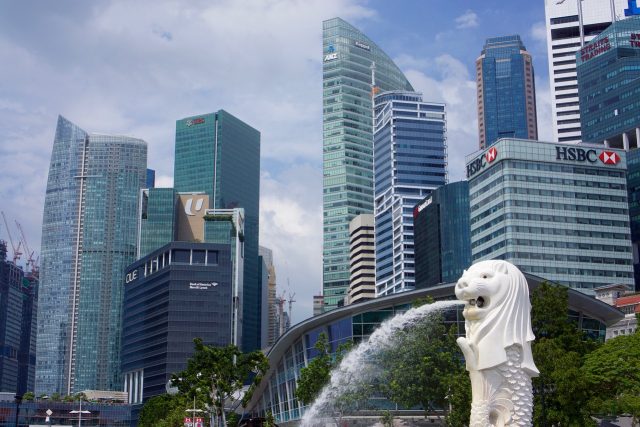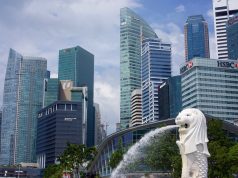Singapore MAS Green Finance Industry Taskforce Launches 3rd Consultation on Green & Transition Taxonomy, Views on Thresholds & Criteria on 5 Areas Agriculture & Forestry, Industrial, Waste & Water, Information & Communications Technology, Carbon Capture & Sequestration
15th February 2023 | Singapore
Singapore Monetary Authority of Singapore (MAS) Green Finance Industry Taskforce (GFIT) has launched the 3rd consultation on Green & Transition Taxonomy, seeking views on thresholds & criteria on 5 areas – Agriculture & Forestry / Land, Industrial, Waste & Water, Information & Communications Technology, and Carbon Capture & Sequestration. Singapore MAS: “This 3rd consultation builds on GFIT’s two earlier rounds of consultations in January 2021 & May 2022, , which proposed thresholds and criteria for the energy, transport and real estate sectors. The eight sectors covered within the taxonomy account for close to 90% of greenhouse gas emissions in South East Asia. GFIT will publish the final taxonomy, which will take into account feedback from all three public consultations, by 1H 2023.” Interested parties may submit their feedback through the Association of Banks in Singapore through this link by 15 March 2023. See full statement below.
“ Singapore MAS Green Finance Industry Taskforce Launches 3rd Consultation on Green & Transition Taxonomy, Views on Thresholds & Criteria on 5 Areas Agriculture & Forestry, Industrial, Waste & Water, Information & Communications Technology, Carbon Capture & Sequestration “
Singapore Monetary Authority of Singapore (MAS) Chief Sustainability Officer & Assistant Managing Director (Development and International) Gillian Tan: “The GFIT taxonomy will drive financing flows to catalyse Asia’s transition to net zero. Adapting international best practices for use in Asia, the taxonomy’s extensive activity and emissions coverage will encourage Singapore-based financial institutions to direct capital flows towards green and transition activities, thereby guiding the region’s transition to a low carbon future.”
Green Finance Industry Taskforce – GFIT is an industry-led initiative comprising representatives from financial institutions, corporates, non-governmental organisations, and financial industry associations. Its mandate is to help accelerate the development of green finance through four key initiatives: (i) develop a taxonomy (ii) enhance environmental risk management practices of financial institutions, (iii) improve disclosures, and (iv) foster green finance solutions.
Singapore MAS Green Finance Industry Taskforce Launches 3rd Consultation on Green & Transition Taxonomy, Views on Thresholds & Criteria on 5 Areas

15th Feb 2023 – 1. The Green Finance Industry Task force (GFIT) is an industry-led initiative comprising representatives from financial institutions, corporates, non-governmental organisations, and financial industry associations. Its mandate is to help accelerate the development of green finance through four key initiatives: (i) develop a taxonomy (ii) enhance environmental risk management practices of financial institutions, (iii) improve disclosures, and (iv) foster green finance solutions. (GFIT), convened by the Monetary Authority of Singapore (MAS), today launched its final public consultation on a green and transition taxonomy for Singapore-based financial institutions. The consultation seeks views on the detailed thresholds and criteria for the classification of green and transition activities in five sectors:
a. agriculture and forestry/land use;
b. industrial;
c. waste and water;
d. information and communications technology; and
e. carbon capture and sequestration.
2. A key proposal of this public consultation is the adoption of a “measures-based approach” for the industrial sector. Unlike other sectors, for the industrial sector, there is a lack of certainty around the technological solutions to achieve net zero. This makes it difficult to determine science-based metrics and thresholds for the “amber” category based on the emissions performance of the activity. In lieu of this, a “measures-based approach” is proposed, which requires the production process of the industrial raw materials to adopt a range of emissions reduction measures. For example, in cement manufacturing, the amber category in the taxonomy provides a list of decarbonisation measures or retrofitting plans which should be put in place to support better energy efficiency outcomes.
3. GFIT has adopted a traffic light classification system to differentiate an activity’s contribution to climate change mitigation, one of five environmental objectivesThe five environmental objectives under the Taxonomy are – (i) climate change mitigation; (ii) climate change adaptation; (iii) protect healthy ecosystem and biodiversity; (iv) promote resource resilience and circular economy; and (v) pollution prevention and control. (EOs) under the taxonomy. A key feature of the GFIT taxonomy is the thresholds and criteria it sets out for transition activities, that allow for a progressive shift towards a net zero outcome across different sectors.
a. A green classification represents activities that contribute substantially to climate change mitigation that is consistent with a net zero outcome, or are on a pathway to net zero by 2050.
b. An amber classification represents transition activities, including those that are either transitioning towards green within a certain time frame, or enabling significant emissions reductions in the short term.
c. A red classification represents harmful activities that are not currently compatible with a net zero trajectory.
4. GFIT is also seeking views on the “Do No Significant Harm (DNSH)” criteria. The criteria specifies that activities which are making a substantial contribution to climate change mitigation should not be carried out in a manner that would cause significant adverse impact to the other four EOs under the taxonomy. To illustrate, the construction of a hydropower generation facility may have met the thresholds and criteria to be classified as a green activity under the climate change mitigation EO. The DNSH criteria would additionally require that the construction and operation of the facility not result in significant adverse impact to the environmental ecosystem within the vicinity of the facility, and the facility owner has to demonstrate that practical measures will be put in place to mitigate any adverse impact.
5. This third consultation builds on GFIT’s two earlier rounds of consultations in January 2021Industry taskforce proposes taxonomy and launches environmental risk management handbook to support green finance and May 2022Industry taskforce consults on second version of green and transition taxonom y, which proposed thresholds and criteria for the energy, transport and real estate sectors. The eight sectors covered within the taxonomy account for close to 90% of greenhouse gas emissions in South East Asia. GFIT will publish the final taxonomy, which will take into account feedback from all three public consultations, by 1H 2023.
6. Ms Gillian Tan, Chief Sustainability Officer and Assistant Managing Director (Development and International), MAS, said, “The GFIT taxonomy will drive financing flows to catalyse Asia’s transition to net zero. Adapting international best practices for use in Asia, the taxonomy’s extensive activity and emissions coverage will encourage Singapore-based financial institutions to direct capital flows towards green and transition activities, thereby guiding the region’s transition to a low carbon future.”
7. Interested parties may submit their feedback through the Association of Banks in Singapore through this link by 15 March 2023.
The five environmental objectives under the Taxonomy are – (i) climate change mitigation; (ii) climate change adaptation; (iii) protect healthy ecosystem and biodiversity; (iv) promote resource resilience and circular economy; and (v) pollution prevention and control.
Sign Up / Register
Caproasia Users
- Manage $20 million to $3 billion of assets
- Invest $3 million to $300 million
- Advise institutions, billionaires, UHNWs & HNWs
Caproasia Platforms | 11,000 Investors & Advisors
- Caproasia.com
- Caproasia Access
- Caproasia Events
- The Financial Centre | Find Services
- Membership
- Family Office Circle
- Professional Investor Circle
- Investor Relations Network
Monthly Roundtable & Networking
Family Office Programs
The 2025 Investment Day
- March - Hong Kong
- March - Singapore
- July - Hong Kong
- July - Singapore
- Sept- Hong Kong
- Sept - Singapore
- Oct- Hong Kong
- Nov - Singapore
- Visit: The Investment Day | Register: Click here
Caproasia Summits
- The Institutional Investor Summit
- The Investment / Alternatives Summit
- The Private Wealth Summit
- The Family Office Summit
- The CEO & Entrepreneur Summit
- The Capital Markets Summit
- The ESG / Sustainable Investment Summit






































